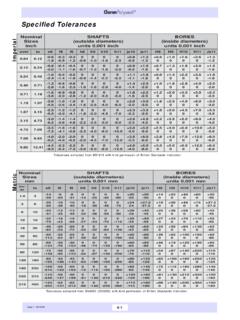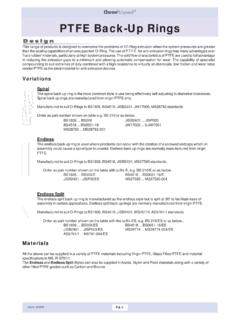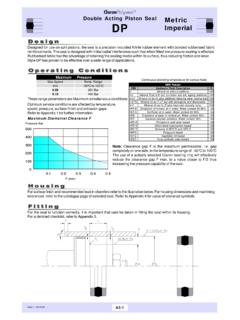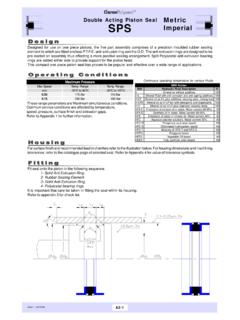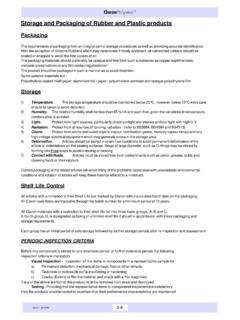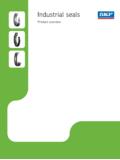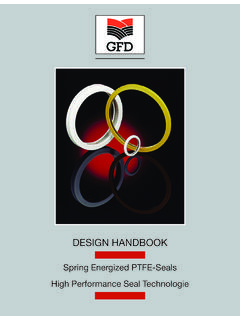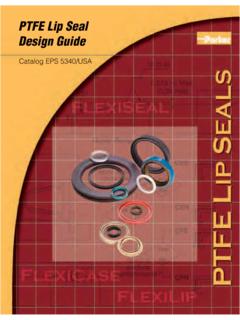Transcription of Seal Selection Guide - Claron Hydraulic Seals Ltd - …
1 ClaronPolyseal At first glance, there are almost as many seal designs as thereare applications. In practice there are only a few principles toapply to any application design and thereafter the constraints ofmaterial choice, production technique and acceptable costdesignate a suitable type of seal . Refinements to variousaspects of seal geometry, material properties and housingdesigns can however have a significant effect on theperformance and capability of the as a manufacturer of Hydraulic pressure Seals in a hugevariety of designs and materials ensure that the productsoffered are based upon the sound knowledge of performanceand suitability for any given application, rather than upon thelimitations of the demand and complexity of the required sealingsystem every seal has the same basic function, to prevent orminimise leakage between the two selecting a seal a series of requirements are made bythose using Seals and these should be given considerationbefore final Selection is made.
2 Environmental Serviceability Simple Installation Operational Reliability Tolerance to the sealing media Frictional requirements Ability to function within a temperature range Good sealing at high and low pressures Resistance to extrusion between mating partsConsideration and evaluation of these demands within the sealsoperating conditions is important as are the influencing factorsof pressure, temperature, speed, and surface affects the seal by forcing it into the gap which existsbetween toleranced machined parts at the non pressure side ofthe seal . When the gap is too large the heel of the seal willshow nibbling and result in premature seal failure. Thisextrusion will increase if the seal is in a condition of sideloading. To minimise extrusion whilst maintaining reasonablemachining tolerances Seals fitted withanti-extrusion wear rings should be selected. The use ofbearing rings will also reduce potential maximum extrusiongaps. Permissible extrusion gaps / pressure graphs are shownfor all piston and rod Seals within this operating temperature of the sealing media affects thechoice of sealing materials.
3 Normal operating temperaturesare usually between 80 C and sometimes 100 C. Theoptimum functional temperature for Seals and oil stability isbetween 40 C and 50 C. At low temperatures the sealmaterial will stiffen and may become brittle although it willrelax as the temperature rises. With high temperatures theseal material will become more elastic and losecompression set. The higher temperatures will also reducethe viscosity of the oil resulting in accelerated wear of theseals. For PTFE Seals the effect of temperature will bebased on the Seals ride on a film of lubricant between the seal lip andmoving surface. The fluid is drawn under by movement andis known as hydrodynamic drag. Friction will depend uponthe thickness of this lubricating film which will be squeezedto its minimum thickness when there is no movement, andcreates stiction. Frictional force begins to decrease with anincrease in velocity as more lubricating fluid is then drawnbetween the seal and moving surface.
4 There is a pointreached with increasing velocity that the frictional forceagain rises and the seal will begin to wear. PTFE Seals havean extremely low coefficient of friction when moving on othersurfaces and may be a possible exception to this operating life of a seal is greatly influenced by theconsiderations of the dynamic surface and the method usedto produce this surface texture. For instance honing androller burnishing may give the same surface finish value butthe surface profile would differ. The aim of all types ofsurface finish is to provide a surface which causes theminimum wear to the seal . Rod Seals because of theirposition in the sealing system are prone to contaminantsentering from the atmosphere and therefore rods should havea surface resistance to corrosion and similar to the besthard chrome. The static surfaces of the seal housing areimportant as the sealing media may pass over the seal if notwithin the recommended surface 2 shows a diagrammatic representationof average roughness value 2 - 20/07/10 Figure 2 These characteristics are defined in DIN EN ISO 4287along with Rmr, mating surface ratio,which should be 50-70% for optimum The average roughness Ra (CLA an abbreviation of centreline average height) is the arithmetic and geometricaverage value of the profile variation in Y direction from themiddle line within the reference length LThe optimum values of surface roughness for various sealtypes is summarised below:-PTFE Seals optimum Ra : - mAbove m :Effect dependant upon Rsk (skewness)Rsk -1: Higher leakage, little wearRsk < -1: High friction and wearBelow m : Friction and wear increasesRubber Seals Dynamic optimum Ra : - mupto m : Slight increase in wearabove m : Wear leakage and friction increasebelow m.
5 High friction and wearRubber Seals Static optimum Ra :< mPolyurethane Seals optimum Ra: < mabove m : Expect high wear and leakageAxial scores : Do not effect seal performance if less m in depthContamination within the system can occur due toinadequate cleaning of parts before assembly or/and dueto operational debris from the seal and bearings. Withlevels of contamination more intensive around the sealarea than in the system generally. The effect ofcontamination is that of seal wear and damage usually inthe form of axial scores. The extent of probability ofleakage will depend upon seal materials with PTFE beingmore prone to leakage when scored. Containments mayalso lodge under the sealing lip allowing a leak materials used in conjunction with Seals may alsoeffect oil contamination due to wear debris with metalbearings producing an increase in leakage probabilityalthough reducing the surface roughness slightly whenused with fluids contain molecules of air which is liberatedby agitation.
6 Air bubbles then occur and an oil vapourcollects usually at the highest point in the of this mixture will result in a temperaturerise causing compression ignition. This process isrepeatable and is known as Diesel effect destroying theseal if repeated frequently. The sealing arrangement maybe protected with the use of Phenolic or phosphor bronzerings strategically housed. Sometimes air bubbles will beforced over the seal face expanding as they move to thelow pressure side of the seal manifesting itself as axialgrooves and resulting in subsequent seal choose Composite Seals ?Composite Seals were originally designed for low- friction orhigh-temperature applications. The development of PTFE andPTFE Compounds in particular, with these capabilities, hasgreatly extended the useful range of these Seals far beyondthat of conventional Rubber / Elastomer based based upon an understanding of lip-geometry anduse of the latest developments in material technology haveallowed Composite Seals to become acceptable in thenormal sphere of operation of Lip- Seals , not just in theextremes of duty for which they were originally optimum speed range for conventional Lip-sealsis - m/sec.
7 And whilst speeds of up to 4 be accommodated this, is only at the expense ofperformance and life. Below m/sec. and above m/secthe friction values rise sharply due to the breakdown of thelubricant film, causing friction and a build-up of heat. Attemperatures above 50 C this additional heat can alsoadversely affect the sealing material, causing swell, hardnessand mechanical property changes, with a resultant loss Seals are obviously desirable at these extremesof speed or even through the optimum working range ofLip- Seals when other factors are taken into Frictional Heat developed per second within slidingcontact is :- Pf = (Watt)Where:-f = coefficient of frictionv = speed (m/sec.)p = load (N/mm )A = dynamic contact area (mm )1-2issue 1 - 20/10/98 ClaronPolyseal Typical examples of the frictional loss of a HydraulicCylinder at various pressures is as follows :-100mm Piston (fitted with DPW style seal ), 60 mm Rod, m/sec.
8 SpeedWithin the range 50 - 200 bar the loss attributable tothe DPW seal is fairly constant at around of thetheoretical pulling power of the cylinder. The lossattributable to the rod Seals is as follows :-Rod seal PressureFrictional LossStyle CPI200 bar180 Kg150 bar120 Kg 50 bar 75 KgStyle CPU 200 bar280 KgStyle CS6 200 bar130 KgStyle Frictional LossCPI1%CPU2% this example it can be seen that the CS6 StyleComposite Seals have distinct advantages overconventional lip Seals in terms of frictional TransportIt must be emphasised that Composite Seals do notgive as dry a rod as conventional Lip- Seals operatingwithin their optimum fitting of two single-acting Composite Seals intandem or the use of a double-acting wiper seal Style941 will significantly contribute towards a practical point of view an absolutely dry rodcannot be achieved without an increase in frictioncausing a considerable reduction in seal life. For anyseal type, oil transport is essential but also variabledependant upon the velocity, viscosity of the oil andthe surface finish of the contact seal design, particularly in relation to thecontact area profile, optimises the amount of oil thatis transported back to the pressure side on the finish is an influencing factor on theperformance of a seal .
9 For Composite Seals ,Cylinder bores and Rods should have a surface finishbetween - m the housing, static sealing surfaces shouldhave a finish better than m after prolonged use, Bronze Filled PTFE will nothave any significant effect on surface finish and Glass filled PTFE are more abrasive andwill slightly reduce the surface finish can be affected by the use of hardbearing materials such as Meehanite, Phosphor-Bronze or is generally recommended that PTFE BearingTape should be used with Composite optimum values of surface roughness for various seal typesis shown in the previous Bearing Tape is specifically designed for use Composite Seals . The nature of allows for amanufactured size giving a tighter fit than harder materials suchas Phosphor-Bronze, Meehanite or Polyester Fabric. Thisreduction in radial clearance gives a marginal improvement tothe pressure capability of the seal but, more importantly,protects the seal from contaminant particles within the combination of the design of the bearing and thecharacteristics of allow the particles to becomeembedded in the on the non-working face, thus alsoprotecting the steel counterface from use, bearing materials wear, causing debris andcontamination of the fluid.
10 Extensive tests have shown thatparticulate contamination >15 m within the fluid, increases withthe use of Phosphor-Bronze or Meehanite, and tends todecrease with the use of The harder debris created bythese bearings also has a greater effect upon seal contamination in the fluid surrounding the seal canbe over 100 times that in the main system due to the bearingpreventing flushing of the seal space. Increased contaminationin this area will increase the probability of a large enoughparticle gaining access to the seal interface, causing damageand 1 - 20/10/98
